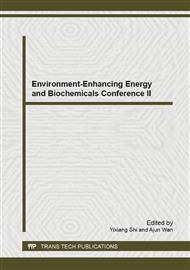p.55
p.63
p.67
p.77
p.85
p.93
p.103
p.111
p.123
Fermentation of Lignocellulosic Wastes for Volatile Fatty Acids at Different Temperatures under Alkaline Condition
Abstract:
In this work, the hydrolysis and acidification of lignocellulosic wastes for volatile fatty acids at different temperatures (10°C~55°C) under strong alkaline condition of pH12 in the anaerobic digestion process of wetland plant litter (WPL) were investigated. The variation of organic carbon sources, sugar and VFAs was examined and the carbon source balance was analyzed during the above process. The results showed that the hydrolysis of WPL was enhanced under strong alkaline condition of pH=12 and the hydrolysis of WPL was accelerated as the temperature increased. The SCOD concentrations in the fermentation liquid increased constantly with temperature, but the percentage of the other carbon that microbe utilized difficultly in SCOD was as high as 45%~69%. Acetic acid was the most dominant VFA. At 25°C, the accumulation of VFAs reached the maximum value of 93mgCOD/g biomass on the 20thd. Twenty-five degrees Celsius could be considered as the optimal conditions for VFAs accumulation at pH=12 in this study as both the quantity and quality of the carbon sources achieved a higher level.
Info:
Periodical:
Pages:
85-91
Citation:
Online since:
February 2013
Authors:
Keywords:
Price:
Сopyright:
© 2013 Trans Tech Publications Ltd. All Rights Reserved
Share:
Citation:


